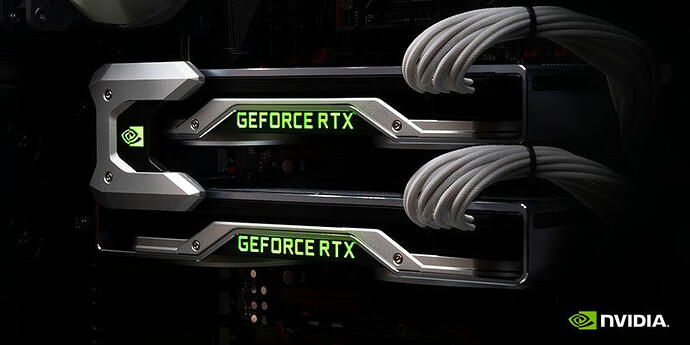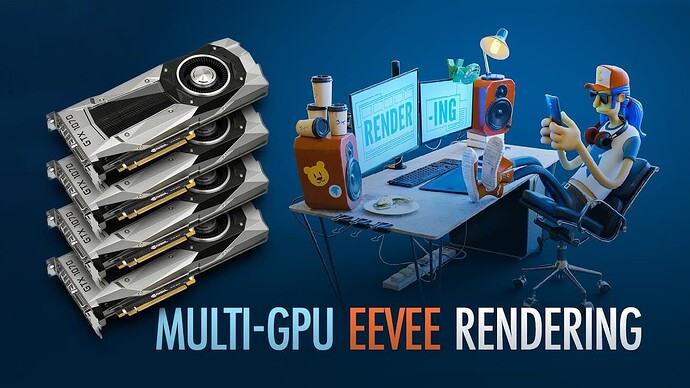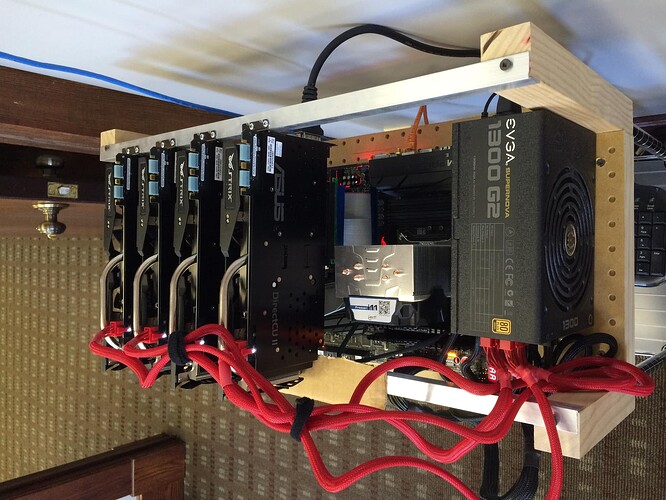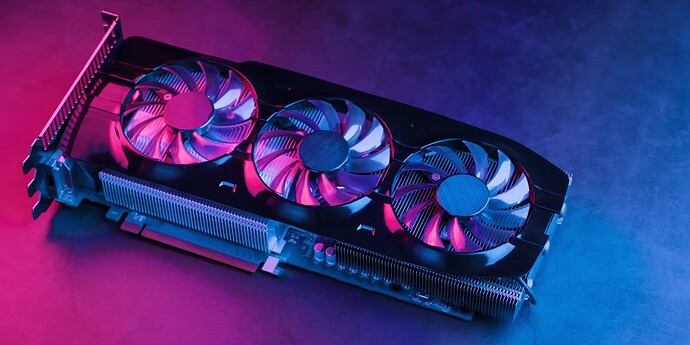In the realm of computer graphics, rendering high-quality visuals is a demanding task that requires significant computational power. As applications become more complex and user expectations rise, the need for efficient rendering solutions has never been more critical. Multi-GPU rendering has emerged as a powerful technique to tackle these challenges. By harnessing the capabilities of multiple graphics processing units (GPUs), developers can significantly improve rendering performance, enhance visual fidelity, and optimize resource utilization. This comprehensive exploration delves into how multi-GPU rendering works, its benefits, techniques, and the future of this technology.
Multi-GPU Rendering
Multi-GPU rendering involves the use of two or more GPUs to accelerate the rendering process. This approach allows for parallel processing of graphical tasks, thereby distributing the workload across multiple units. The concept hinges on the principle of parallelism, where tasks that can be performed simultaneously are executed across multiple GPUs. This leads to a more efficient use of resources and faster rendering times.
The Need for Multi-GPU Solutions
The demand for multi-GPU rendering arises from various factors:
- Increased Complexity of Graphics: Modern applications, especially in gaming, film, and virtual reality, feature highly detailed graphics, complex shaders, and intricate lighting effects. These demands require immense computational power that a single GPU may struggle to provide.
- Higher Resolutions and Frame Rates: As display technology advances, users expect higher resolutions (e.g., 4K, 8K) and smoother frame rates (e.g., 60 FPS, 120 FPS). Meeting these expectations often necessitates additional processing power.
- Real-Time Rendering Requirements: In environments like virtual reality and interactive gaming, real-time rendering is crucial. Multi-GPU setups can help achieve the necessary performance levels to provide a seamless user experience.
- Emerging Technologies: Advanced rendering techniques, such as ray tracing and complex particle simulations, require substantial computational resources. Multi-GPU rendering provides an effective way to tackle these demanding tasks.
How Multi-GPU Rendering Works
Multi-GPU rendering operates on the principle of distributing rendering tasks across multiple GPUs. There are several approaches to achieve this, each with its own methodology and advantages.
1. Split Frame Rendering
In split frame rendering, the image is divided into sections, and each GPU is responsible for rendering a portion of the frame. This method allows for effective load balancing, as each GPU processes its segment independently.
- Advantages: This approach can significantly speed up rendering times, especially for high-resolution images. Each GPU works on a smaller task, allowing for efficient use of resources.
- Disadvantages: The challenge lies in ensuring that the edges of the split frames blend seamlessly to produce a coherent final image. Additional overhead may be required for synchronization and data transfer between GPUs.
2. Alternate Frame Rendering
Alternate frame rendering (AFR) involves rendering alternate frames using different GPUs. For example, while one GPU renders frame 1, another GPU can simultaneously work on frame 2. This method leverages the capabilities of multiple GPUs to achieve higher frame rates.
- Advantages: AFR can lead to significant performance improvements, particularly in real-time applications. Users experience smoother animations and reduced latency.
- Disadvantages: This technique may introduce challenges in synchronization between frames, requiring careful management to avoid issues such as tearing or stuttering.
3. Tile-Based Rendering
Tile-based rendering divides the frame into smaller tiles, and each GPU is assigned specific tiles to render. This method allows for efficient memory usage and reduces the amount of data that needs to be processed at once.
- Advantages: Tile-based rendering can improve performance by minimizing memory bandwidth requirements. It also allows for better culling of unseen objects, further enhancing efficiency.
- Disadvantages: The overhead of managing tiles and coordinating between GPUs can complicate implementation. Additionally, it may not be suitable for all types of rendering tasks.
4. Hybrid Approaches
Some rendering engines employ hybrid approaches that combine elements of split frame, alternate frame, and tile-based rendering. By adapting the strategy based on the specific requirements of the scene or application, developers can optimize performance further.
- Advantages: Hybrid methods can provide flexibility and adaptability, allowing for tailored solutions that maximize resource utilization.
- Disadvantages: The complexity of implementing hybrid approaches can increase development time and may introduce additional challenges in synchronization and load balancing.
Benefits of Multi-GPU Rendering
The advantages of multi-GPU rendering extend beyond mere performance improvements. Several key benefits make this approach appealing for developers and users alike.
1. Enhanced Performance
The most obvious benefit of multi-GPU rendering is the significant increase in rendering performance. By distributing workloads across multiple GPUs, developers can achieve faster rendering times, allowing for real-time rendering of complex scenes. This is particularly valuable in gaming and interactive applications where responsiveness is crucial.
2. Improved Visual Quality
Multi-GPU setups can handle more complex scenes with higher detail levels. This capability allows for the use of advanced rendering techniques, such as ray tracing, which can create stunning visuals with realistic lighting and shadows. The ability to render more intricate details contributes to a more immersive user experience.
3. Future-Proofing
As technology continues to evolve, applications will demand even more computational power. Multi-GPU rendering provides a scalable solution that allows developers to accommodate future advancements in graphics technology. By investing in multi-GPU setups, developers can ensure their applications remain relevant and capable of meeting user expectations.
4. Resource Optimization
Multi-GPU rendering allows for better resource management. By distributing tasks across multiple GPUs, developers can avoid bottlenecks that may occur with a single GPU. This optimization leads to more efficient use of memory and processing power, ultimately resulting in a smoother user experience.
5. Enhanced Workflow Efficiency
For professionals in fields such as 3D modeling, animation, and visual effects, multi-GPU rendering can significantly enhance workflow efficiency. Rendering times can be reduced, allowing artists to iterate more quickly and focus on the creative aspects of their work rather than waiting for lengthy render processes.
Challenges and Considerations
While multi-GPU rendering offers numerous benefits, it also presents challenges that developers must address to ensure successful implementation.
1. Complexity of Implementation
Setting up a multi-GPU rendering environment can be complex. Developers must choose the right hardware, configure drivers, and ensure compatibility between GPUs. Additionally, selecting the appropriate rendering technique for a given application can require careful consideration.
2. Synchronization Overhead
Multi-GPU rendering introduces synchronization overhead, as GPUs must communicate and coordinate their efforts. This overhead can impact performance if not managed correctly. Developers need to implement efficient communication protocols to minimize latency and ensure smooth rendering.
3. Diminishing Returns
As more GPUs are added to a rendering setup, the performance gains may not scale linearly. Diminishing returns can occur due to factors such as increased synchronization overhead and bottlenecks in other system components (e.g., CPU, memory). Developers must be mindful of these limitations when designing multi-GPU solutions.
4. Software Compatibility
Not all rendering engines or applications support multi-GPU rendering. Developers must ensure that the software they are using can take advantage of multiple GPUs. This may involve using specific APIs or frameworks that facilitate multi-GPU rendering.
5. Cost Considerations
Investing in multiple GPUs can be expensive. Developers and organizations must weigh the performance benefits against the costs associated with procuring and maintaining multi-GPU setups. Budget constraints may limit the feasibility of multi-GPU rendering for some users.
Multi-GPU Rendering in Different Applications
Multi-GPU rendering has found applications across various industries and fields. Understanding how different sectors leverage this technology can provide insights into its versatility and effectiveness.
1. Gaming
The gaming industry is one of the primary beneficiaries of multi-GPU rendering. Modern games feature complex graphics, expansive worlds, and intricate details that require substantial computational power. Multi-GPU setups allow developers to achieve higher frame rates and smoother gameplay, enhancing the overall gaming experience.
- Examples: Popular gaming titles often incorporate multi-GPU rendering techniques to provide players with stunning visuals and immersive environments. Games like “Cyberpunk 2077” and “Call of Duty: Warzone” utilize multi-GPU capabilities to deliver high-performance experiences on powerful gaming rigs.
2. Film and Animation
In the film and animation industry, rendering high-quality visuals is paramount. Multi-GPU rendering can significantly speed up the rendering of complex scenes, allowing studios to produce visually stunning content more efficiently.
- Examples: Major film studios use multi-GPU rendering farms to handle the demanding rendering tasks associated with animated films and visual effects. Movies like “Avengers: Endgame” and “Frozen II” utilize advanced rendering techniques that benefit from multi-GPU setups.
3. Architectural Visualization
Architects and designers often rely on rendering software to create realistic visualizations of their projects. Multi-GPU rendering can enhance the quality and speed of these visualizations, allowing clients to see detailed representations of buildings and spaces.
- Examples: Architectural visualization software such as Lumion and V-Ray supports multi-GPU rendering, enabling architects to create lifelike renderings of their designs. This capability facilitates better communication with clients and stakeholders.
4. Virtual Reality (VR)
Virtual reality applications require real-time rendering to provide immersive experiences. Multi-GPU rendering can help achieve the high frame rates and low latency necessary for comfortable VR experiences.
- Examples: VR applications that feature complex environments, such as architectural walkthroughs or gaming experiences, benefit from multi-GPU setups. These configurations enable smooth interactions and realistic visuals, enhancing the overall immersion.
5. Scientific Visualization
In fields such as medical imaging and scientific research, rendering complex datasets is crucial. Multi-GPU rendering can accelerate the visualization of large datasets, allowing researchers to analyze and interpret data more effectively.
- Examples: Scientific visualization software often employs multi-GPU rendering techniques to handle large volumes of data, such as 3D medical scans or simulations of physical phenomena. This capability enables researchers to gain insights from their data more efficiently.
The Future of Multi-GPU Rendering
As technology continues to advance, the future of multi-GPU rendering holds exciting possibilities. Several trends and innovations are likely to shape this field in the coming years.
1. AI Integration
The integration of artificial intelligence (AI) into rendering workflows has the potential to revolutionize multi-GPU rendering. AI algorithms can analyze rendering tasks, optimize resource allocation, and enhance performance, making multi-GPU setups even more efficient.
- Future Implications: AI-driven rendering techniques may enable more intelligent load balancing, real-time adjustments, and improved synchronization between GPUs. This could lead to significant performance gains and enhanced visual quality.
2. Cloud-Based Rendering
The rise of cloud computing has opened new avenues for rendering. Cloud-based rendering solutions can leverage multiple GPUs in remote data centers, allowing users to access powerful rendering capabilities without the need for expensive local hardware.
- Future Implications: As cloud-based rendering becomes more prevalent, users will have the flexibility to scale their rendering power according to their needs. This approach can democratize access to high-performance rendering capabilities, benefiting a wider range of users.
3. Improved Software Support
As multi-GPU rendering gains traction, software developers are likely to enhance support for multi-GPU setups. This includes optimizing rendering engines, developing new APIs, and providing tools that facilitate multi-GPU rendering workflows.
- Future Implications: Improved software support will make it easier for developers to implement multi-GPU rendering, enabling more applications to take advantage of this technology. This could lead to broader adoption across various industries.
4. Hardware Advancements
The development of more powerful and efficient GPUs will continue to drive the evolution of multi-GPU rendering. As manufacturers release new generations of GPUs with enhanced capabilities, multi-GPU setups will become increasingly capable of handling more demanding rendering tasks.
- Future Implications: Advancements in GPU architecture, memory bandwidth, and power efficiency will enhance the performance of multi-GPU rendering. Users can expect to see significant improvements in rendering speed and visual quality.
5. Enhanced User Experience
Ultimately, the goal of multi-GPU rendering is to enhance the user experience. As rendering technology improves, users will benefit from faster rendering times, higher quality visuals, and more immersive experiences.
- Future Implications: The synergy between multi-GPU rendering and emerging technologies will lead to innovative applications and experiences. Users can look forward to a future where rendering capabilities continually evolve to meet their expectations.
Bottom Words
Multi-GPU rendering represents a powerful solution for enhancing performance in graphics rendering. By leveraging the capabilities of multiple GPUs, developers can achieve significant improvements in rendering speed, visual quality, and resource optimization. The various approaches to multi-GPU rendering, including split frame rendering, alternate frame rendering, tile-based rendering, and hybrid methods, provide flexibility in addressing the diverse needs of applications across industries.
While challenges such as complexity of implementation, synchronization overhead, and diminishing returns must be carefully managed, the benefits of multi-GPU rendering are undeniable. From gaming and film to architectural visualization and scientific research, multi-GPU rendering has the potential to transform how we create and experience graphics.
As technology continues to advance, the future of multi-GPU rendering looks promising. The integration of AI, the rise of cloud-based rendering, improved software support, and hardware advancements will shape this field in exciting ways. Ultimately, the goal remains the same: to enhance user experiences through faster, more efficient, and visually stunning rendering. The journey of multi-GPU rendering has just begun, and the possibilities are limitless.



